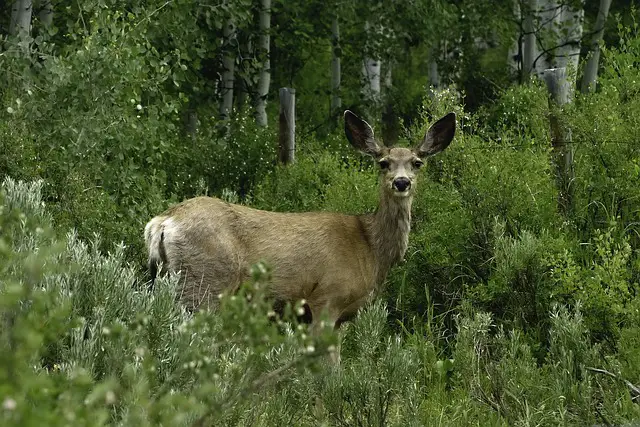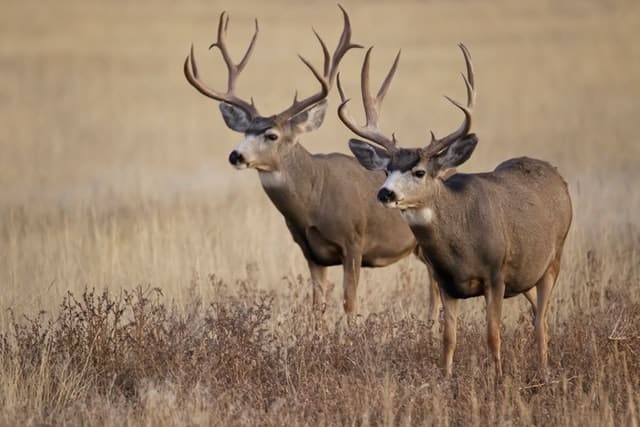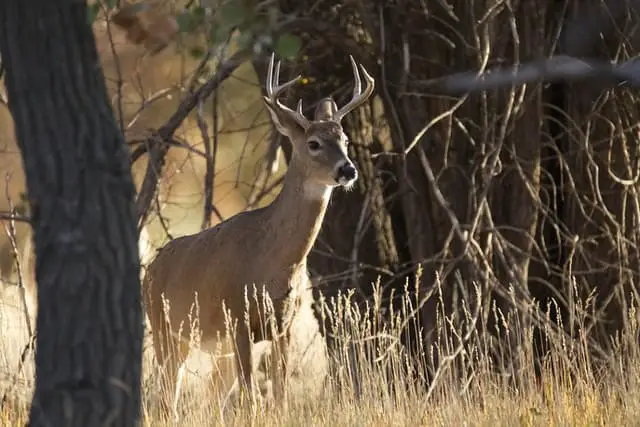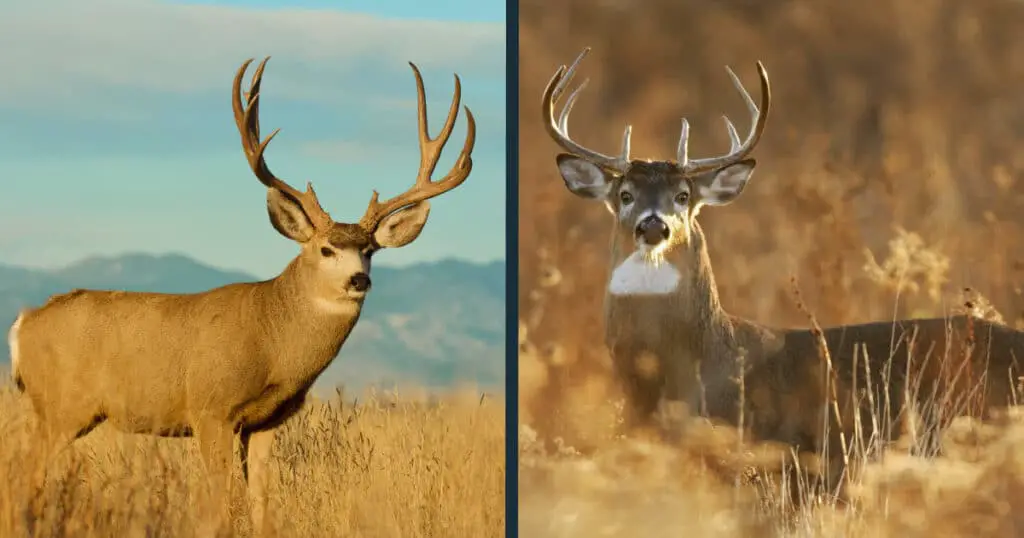If you’re a hunter or nature enthusiast in areas where there are deer, you are probably keen to find out the differences between mule deer and whitetail deer. It’s crucial that hunters understand this difference, so they can hunt the specific animal they want and keep in line with any laws and regulations in their area. In this article, we will compare mule deer vs whitetail deer.
We’ll consider the differences in size, coloring, mating habits, antlers, habitat, and behavior. Furthermore, we’ll consider distinctions between both male and female deer, where the different species are found in the world, as well as some of the unique characteristics of each species.
This should provide a complete whitetail deer vs mule deer comparison.
Mule Deer vs Whitetail Deer Comparison Table
Let’s start with a quick side-by-side table and then we’ll dig into the specifics of what makes each species of deer unique from the other.
| Whitetail Deer | Mule Deer | |
| Size | Whitetail deer usually weigh between about 90 to 200 pounds. Sometimes male whitetail deer can weigh over 400 pounds. | Mule deer are larger than whitetail deer, usually weighing between 100 and 220 pounds. In some areas, including northern regions, bucks can be as heavy as 450 pounds |
| Coloring | Whitetail deer tails are usually thick and dark in color, with a narrow bright white patch beneath it. When they sense danger, whitetail deer lift their tails, exposing the patch as they run away. Whitetail deer have reddish-brown fur that turns grey in the winter months. | It has a larger area of white above their tail. The tail is rope-like and white with a black tip. |
| Mating habits | Whitetail deer tend to have more babies than mule deer. Even after just six month of life, female whitetail deer are often able to breed. The whitetail breeding season is between late November and early December. Female whitetail deer pregnancy lasts about six and a half months. | Mule deer mating season takes place between mid to late November every year. The gestation period for the mule deer is seven months. |
| Antlers | Whitetail bucks have a primary beam the antler develops from, separating into different directions and forming different points. Antlers shed in January or February. The number of antler points is not a good indication of a buck’s age. | Mule deer buck racks are bifurcated. As they grow, they fork off in two different directions. They will later split once more to make a greater number of tines, or the points. Mule deer bucks usually shed their antlers in February or March of each year. Mature racks of mule deer bucks are generally broader and extend higher than the racks of equivalent whitetails. |
Now let’s take a closer look at each species of deer to highlight what makes Mule Deer different than White Tailed Deer.
Mule Deer
The mule deer’s scientific name Odocoileurs hamionus (which in Latin means half-mule).
Ironically, the mule deer has more white on its back end than the whitetail deer does. Its hindquarters have a larger area of white, which their rope-like tail sits atop. The tail is itself is white as well, though it is tipped with black.
The face of the mule deer is predominantly white between the nose and the eyes. The mule deer has a patch of white on the throat. The mule deer has larger ears than those of the whitetail. Its ears sit at approximately a 30-degree angle on the animal’s head.

In some areas, male mule deer are bigger than whitetail deer. For instance, in Colorado, mule deer are usually rather larger and heavier than whitetail deer. Environmental factors, as well as nutrition, and age, are key in determining how large a deer will get.
Size
Mule deer usually weigh between 100 and 220 pounds. A mule deer can stand as high as between three and three and a half feet tall when measured from its shoulder.
Mule deer bucks at the heaviest range can weigh as much as 450 pounds or more. These deer would generally be considered trophy-size. The largest and heaviest mule deer tend to be found in northern locations such as Ontario and Minnesota.
Antlers
Mule deer bucks usually shed their antlers in February or March of each year.
Mature racks of mule deer bucks are generally broader and extend higher than the racks of equivalent whitetails.

Mule deer buck racks are bifurcated. This means that as they grow, they fork off in two different directions. They will later split once more to make a greater number of tines (tines are points on the antlers).
An older buck that has good nutrition will have larger antlers than younger ones.
Other Behavior
Mule Deer mating season takes place between about middle to late November of each year. The gestation period for the mule deer is seven months.
The mule deer generally has fur that is grayish-brown in tone. You should be aware, though, that whitetail fur can become quite grayish in the winter too, so you shouldn’t try to use color as a basis for distinguishing between the two species.
When mule deer run, they tend to bound in a kind of hopping motion, with stiff legs. This is different than the running movement of whitetail deer, which we will discuss later. Mule deer tend to have a surprisingly relaxed attitude and are generally less wary of hunters and humans.
Whitetail Deer
The whitetail deer normally has a tail that is dark in color and quite thick. It has a narrow patch of bright white beneath this. You will see this patch very vividly when the deer lifts its tail because if it’s on alert or feels it is in danger.

Whitetail deer usually have reddish-brown fur. As mentioned in the previous section, though, their fur does become a bit grayish during the winter months.
Size
Whitetail deer vary significantly in size and usually weigh between about 90 to 200 pounds. Size also generally depends on where the deer is located. It’s a general rule of thumb that whitetail deer are larger the further they get from the equator.
Antlers
The antlers of a whitetail buck will initially have one primary beam, then from that beam, the antler will grow in different directions, creating different points.

Whitetail deer antlers generally shed in January or February. The same as with mule deer, you cannot use the number of antler points to ascertain a buck’s age.
Mating
Whitetail deer have a higher birth rate than mule deer. Female whitetail deer can breed as young as six months old. Whitetail deer mate between late November and early December.
The gestation period for whitetail deer lasts six and a half months.
Other Behavior
Whitetail deer raise their tails (showing the white) and run as fast as they can when they are startled.

While whitetail deer are more skittish than mule deer when humans are around, they can be surprisingly aggressive. Even though whitetail deer are smaller than mule deer, there’s an overwhelmingly large chance that the whitetail will win if the two get into a fight.
Mule Deer vs Whitetail Deer: Similarities
While there are differences between Mule Deer and Whitetail Deer, there are also plenty of similarities. These should be noted in any article comparing the two species, and we’ll do so here:
- Both species of deer have two-color (dichromatic) vision, with yellow and blue as the primaries. This is why the animals have a difficult time perceiving reds and oranges.
- Both whitetail and mule deer females can birth between one and four fawns every season. The first season a doe gives birth, she normally has just one fawn. After that, she will usually have two fawns at a time.
- Fawns (or baby deer) are generally reddish in color with white spots – something which is true for both species. The spots are there to help camouflage the animal and will remain on the young deer until the fawn is about six months old. That said, the spots will start to fade when the animal is just one month old in both Mule Deer and Whitetail Deer.


